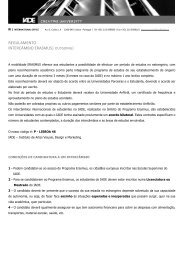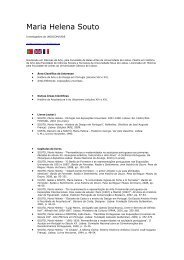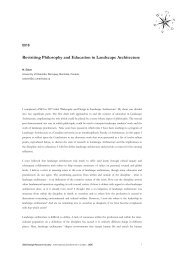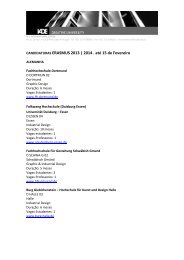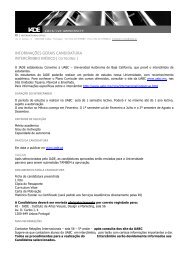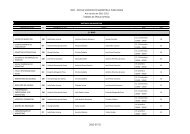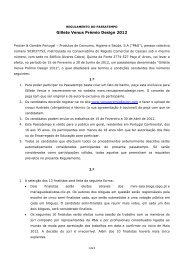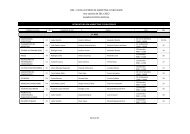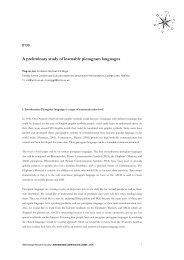0053 Conventions of Typography Related to Traditional Poetry - IADE
0053 Conventions of Typography Related to Traditional Poetry - IADE
0053 Conventions of Typography Related to Traditional Poetry - IADE
You also want an ePaper? Increase the reach of your titles
YUMPU automatically turns print PDFs into web optimized ePapers that Google loves.
<strong>0053</strong><br />
<strong>Conventions</strong> <strong>of</strong> <strong>Typography</strong> <strong>Related</strong> <strong>to</strong> <strong>Traditional</strong> <strong>Poetry</strong><br />
HS Pacheco<br />
1 The University <strong>of</strong> Reading, Reading, Berkshire, United Kingdom, 2 CNPq, Brasilia, Distri<strong>to</strong> Federal, Brazil<br />
h.s.pacheco@rdg.ac.uk<br />
<strong>Poetry</strong> is a distinctive type <strong>of</strong> text characterised by its layout, which is determined by the poet, not by the<br />
designer. However, before printing, this text has <strong>to</strong> adapt <strong>to</strong> constraints related <strong>to</strong> printing and publishing rules<br />
as well as <strong>to</strong> costs. These constraints can directly affect the layout and this creates a tension between the<br />
original text and the final result. Clearly the layout <strong>of</strong> poetry can affect its intended meaning and how it is<br />
unders<strong>to</strong>od by its readers. In traditional poetry, where the text is characterised by regular meter and fixed<br />
poetic form, such difficulties occur. It is desirable, therefore, <strong>to</strong> establish printing and publishing rules which<br />
respect such fixed forms and regularity <strong>of</strong> text, whilst at the same time conforming <strong>to</strong> printing and publishing<br />
constraints. Unfortunately, books about typography and manuals <strong>of</strong> style have always treated this subject all<br />
<strong>to</strong>o superficially, as this paper will show.<br />
The earliest printer’s manuals<br />
According <strong>to</strong> Fishman (1974:859), ‘tradition in the widest sense signifies consciousness <strong>of</strong> the past’; tradition,<br />
therefore, related <strong>to</strong> poetry involves its whole his<strong>to</strong>ry. This his<strong>to</strong>ry includes how traditional poetry uses stress<br />
and sound <strong>to</strong> measure and foreground what Bradford calls ‘the principal structural characteristic <strong>of</strong> the poem:<br />
the line’ (Bradford, 1997:16). In terms <strong>of</strong> the typography <strong>of</strong> poetry, its whole his<strong>to</strong>ry is closely linked <strong>to</strong> the<br />
conventions which scribes adopted in order <strong>to</strong> commit poetic lines <strong>to</strong> the page. Up until the time that scribes<br />
start <strong>to</strong> put the poems on the page, poetry had always been transmitted orally. In the age <strong>of</strong> the printing-press,<br />
manuals were developed in order <strong>to</strong> involve printers in both technical and grammatical issues. In order <strong>to</strong><br />
establish the typographical background <strong>of</strong> poetry it is important <strong>to</strong> understand the conventions poetry has used<br />
in the past. Printers’ manuals are an interesting his<strong>to</strong>rical source because they describe the earliest working<br />
methods <strong>of</strong> the printer, although none are early enough <strong>to</strong> show the very earliest working methods. They were<br />
first produced in the seventeenth century. The very earliest printer’s manual, called Mechanick exercises: or, the<br />
doctrine <strong>of</strong> handy-works. Applied <strong>to</strong> the art <strong>of</strong> printing, was written by Joseph Moxon in 1677. However, there is no<br />
mention <strong>of</strong> how poetry was set on the page in this work. The typographical approach is all related <strong>to</strong> prose.<br />
This lack <strong>of</strong> information about poetry is common <strong>to</strong> most earlier printers’ manuals. John Smith’s Printer’s<br />
grammar (1755), John Johnson’s Typographia or The printers’ instruc<strong>to</strong>r (1824), Edward Grattan’s The printer’s<br />
companion (1846) Arthur Oldfield’s A practical manual <strong>of</strong> typography (1890) and Charles Thomas Jacobi’s Printing<br />
2006 Design Research Society . International Conference in Lisbon . <strong>IADE</strong> 1
(1890) only mention poetry when describing the work <strong>of</strong> the composi<strong>to</strong>r. Some manuals do not mention<br />
poetry at all, such as Caleb S<strong>to</strong>wer’s The printer’s manual (1817), T.C. Hansard’s Typographia (1825), Charles<br />
Henry Timperley’s Printer’s manual (1838), the American manual <strong>of</strong> printing: Typographia: or the printer’s instructions<br />
written by Thomas Adams and published in 1844, Thomas Lynch’s The printer’s manual (1859) and Thomas<br />
Mackellar’s The American printer: a manual <strong>of</strong> typography (1870). There are exceptions, such as W.H. Tickle’s The<br />
printers’ manual (1828) in which poetry is mentioned in the section on ‘capitalization’. Here, Tickle lists the<br />
situations in which capitals should be used. Situation number nine states: ‘9. At the beginning <strong>of</strong> every line <strong>of</strong><br />
poetry’ (Tickle, 1828:20). Another exception is found in the Manuel typographique written by Pierre-Simon<br />
Fournier in 1764. Here he shows a condensed typeface which he created especially for poetry. In the<br />
description <strong>of</strong> the characteristics <strong>of</strong> this condensed typeface, he states the importance <strong>of</strong> shortening the lines in<br />
order <strong>to</strong> avoid turnover lines:<br />
Another advantage <strong>of</strong> thus compressing the letters laterally against one another is that<br />
verse lines <strong>of</strong> ten or twelve syllables are not <strong>to</strong>o long for the page, and there is no need<br />
<strong>to</strong> make two lines <strong>of</strong> them, or, as it is called, turn them in.<br />
(Translated from French in<strong>to</strong> English in Carter, 1973:170)<br />
He emphasizes that the excess <strong>of</strong> turnover lines creates blocks <strong>of</strong> white on the page which are reinforced by<br />
the blank space already left by lines which do not extend the full width <strong>of</strong> the page, which a common<br />
characteristic <strong>of</strong> poetry. He says that these blocks are <strong>of</strong>fensive <strong>to</strong> the eye. He stresses that ‘the new type<br />
prevents this eyesore’ (Carter, 1973:170).<br />
The twentieth-century manuals<br />
By the twentieth century manuals <strong>of</strong> style had developed from these printers’ manuals. They were useful not<br />
only <strong>to</strong> printers, but also <strong>to</strong> authors. However, during this period <strong>of</strong> development, some <strong>of</strong> the printer’s<br />
manuals and manuals <strong>of</strong> style gave a similar lack <strong>of</strong> information about poetry: Henry Kenyon Stephenson’s<br />
Printing (1941), Thwaites’s Printers publishers authors handbook (1948), James Jarret’s Printing style for authors,<br />
composi<strong>to</strong>rs and readers (1960) do not mention poetry at all.<br />
In 1893, Horace Hart wrote a manual for composi<strong>to</strong>rs and readers called Hart’s rules. This work developed in<strong>to</strong><br />
the manual <strong>of</strong> style <strong>of</strong> The Oxford University Press, The Oxford guide <strong>to</strong> style. In the Hart’s rules editions from<br />
1893 until the late twentieth century, more space is gradually devoted <strong>to</strong> poetry, although the greatest space is<br />
still related <strong>to</strong> how <strong>to</strong> quote poetry within prose texts. The field <strong>of</strong> prose is without doubt the main focus <strong>of</strong><br />
interest. However, some manuals <strong>of</strong> style from the twentieth century and some books about editing do<br />
mention poetry in more detail, such as R.A. Hewitt’s Style for print and pro<strong>of</strong> correcting (1957), Marjorie Skillin and<br />
Robert Gay’s Words in<strong>to</strong> type (1974), Judith Butcher’s Copy-editing (1992), The Chicago manual <strong>of</strong> style (1993) and<br />
Ritter’s Oxford guide <strong>to</strong> style (2002). Books or articles about typography, composition and his<strong>to</strong>rical aspects <strong>of</strong><br />
writing and typography have also devoted some space <strong>to</strong> poetry such as De Vinne’s Correct composition (1902),<br />
Bernard Newdigate’s On printing poetry (Thorpe, 1950), Oliver Simon’s Introduction on typography (1945), Norman<br />
Hidden’s The poet’s guide (1979), Jan Tschichold’s Asymmetric typography (1967), Hugh Williamson’s Methods <strong>of</strong> book<br />
design (1956), Ullman’s Ancient writing and its influence (1963), Ruari McLean’s Manual <strong>of</strong> typography (1980), Robert<br />
Bringhurst The elements <strong>of</strong> typographic style (1992), M.B. Parkes’ Pause and effect: punctuation on the west (1992) and<br />
2006 Design Research Society . International Conference in Lisbon . <strong>IADE</strong> 2
Hochuli and Kinross’s Designing books (1996). These works provide only a fragmented overview <strong>of</strong> how poetry<br />
has been treated over the decades. Because their main focus <strong>of</strong> interest is prose, it is interesting <strong>to</strong> consider<br />
why such books on typography have never given much information relating <strong>to</strong> the typesetting <strong>of</strong> poetry.<br />
<strong>Poetry</strong> and prose: the differences<br />
<strong>Poetry</strong> has been dealt with in a similar way <strong>to</strong> drama and musical notation. Special sections within the above<br />
books have been devoted <strong>to</strong> these <strong>to</strong>pics. According <strong>to</strong> Oliver Simon, ‘printing <strong>of</strong> poetry is more complex than<br />
printing <strong>of</strong> prose, and any rules must allow for many exceptions.’ (Simon, 1945:48). Prose is a kind <strong>of</strong> text<br />
which adapts flexibly <strong>to</strong> rules <strong>of</strong> composition, styles <strong>of</strong> publishing houses and sizes <strong>of</strong> pages because the<br />
original manuscript does not have any special importance in relation <strong>to</strong> the shape <strong>of</strong> the text. The handling <strong>of</strong><br />
beginnings, headings and paragraphs, for example, normally conform <strong>to</strong> rules which govern the final shape <strong>of</strong><br />
the text on the page, <strong>to</strong>gether with grammar and syntax.<br />
Conversely, poetry deals with texts in which the author’s manuscript does have a special importance.<br />
Moreover, poetry, according <strong>to</strong> Richard Bradford (1997:15), ‘supplements the use <strong>of</strong> grammar and syntax with<br />
another system <strong>of</strong> organization: the line’. Hence, poetry is concerned with pre-determined breaking lines,<br />
specific groups <strong>of</strong> lines (stanzas) and the relationship between the lines (rhyme) which dictate the shape <strong>of</strong> the<br />
text.<br />
This shape is commented on A. R. Braunmuller (1993:47):<br />
Non-semantic physical attributes – an unjustified right-hand margin, capitals at the start <strong>of</strong> each line – signal<br />
formal properties <strong>of</strong> the text. In turn, these formal features stipulate conventional relations among writer, text,<br />
and reader; they tell us how we are expected <strong>to</strong> regard the text. These texts are poetry, or at least verse, and<br />
must be read as such because <strong>of</strong> their margins and their capitals.<br />
How the designer, printer or edi<strong>to</strong>r deals with the author’s manuscript (a text presented by the author, whether<br />
literally, a manuscript, a typescript or a computer print-out ) is a crucial point. The shape <strong>of</strong> a text in prose is<br />
not necessarily defined by this manuscript, and the edi<strong>to</strong>r is the person who takes the decisions about how <strong>to</strong><br />
set this text on the page. It is understandable, therefore, that manuals have been made <strong>to</strong> guide this job. By<br />
contrast, the shape <strong>of</strong> poetry is basically defined by the author’s manuscript, which partly explains why<br />
manuals do not deal with a text which comes with its own rules.<br />
In poetry, according <strong>to</strong> Stillman (1966:viii), ‘the line is a unit <strong>of</strong> language in a poem’ and it is ‘the unit that is the<br />
distinctive feature <strong>of</strong> poems’, according <strong>to</strong> Bradford (1996:3). In prose, the line is a simple typographic line. It<br />
is important <strong>to</strong> point out again the difference between a ‘poetic’ line and a ‘typographic’ line. In the former, the<br />
line is <strong>of</strong> special importance as it is determined by its author, and in the latter it has been determined by type<br />
size available and line length rather than by its author. The Chicago manual <strong>of</strong> style (1993) <strong>to</strong>uches on this point<br />
when it explains the difference between ‘prose’ and ‘poetry’ from a typographical point <strong>of</strong> view. According <strong>to</strong><br />
this manual, prose is a text in which the length <strong>of</strong> a line is determined by the designer, unlike poetry, where ‘the<br />
length <strong>of</strong> line is determined by the author’. Bernard Newdigate (1869-1944) from the Shakespeare Head Press,<br />
also refers <strong>to</strong> line-endings in poetry saying that ‘jagged ends <strong>of</strong> the verse are a condition which no printer’s<br />
2006 Design Research Society . International Conference in Lisbon . <strong>IADE</strong> 3
ingenuity can control’ (Thorpe, 1950:22). However, he still prefers <strong>to</strong> have some control within such a text; he<br />
suggests that printers can control spacing between words in order <strong>to</strong> make the line longer or shorter. Since<br />
such books are dedicated <strong>to</strong> discussing an area which gives edi<strong>to</strong>rs more control than authors, it is logical and<br />
understandable that they focus on prose issues mainly because they clearly cannot suggest typographical rules<br />
for unpredictable forms <strong>of</strong> poetry. However, when the layout <strong>of</strong> a text is determined by a person who is not<br />
involved in the production <strong>of</strong> the book, in this case, the poet, his decisions impact on the edi<strong>to</strong>r’s<br />
typographical choices.<br />
The line length is one such typographical choice which is an essential part <strong>of</strong> written and printed poetry, but<br />
there are a number <strong>of</strong> other typographical features, such as indentation, the alignment <strong>of</strong> the poem on the<br />
page, the use <strong>of</strong> capital letters and the blank spaces within the poem which are also significant in defining the<br />
typography <strong>of</strong> poetry. Models and rules which poets have followed throughout the centuries are found in the<br />
traditional forms <strong>of</strong> poetry. Such traditional forms can be seen in traditional stanza forms such as terza rima,<br />
rhyme royal or Spenserian stanza, and traditional poem forms, such as the Shakespearean sonnet, the Spenserian<br />
sonnet and the ballade.<br />
It has been seen how printers’ manuals, manuals <strong>of</strong> style and books about typography do relate <strong>to</strong> poetry in an<br />
inconsistent way. They include comments on several useful features. In order <strong>to</strong> look closely at these features,<br />
the following section will concentrate on rules and prescriptions within the twentieth-century material<br />
identified in the previous section, as these provide a fuller source <strong>of</strong> information than manuals from the<br />
previous centuries.<br />
Advice for typesetting poetry within twentieth century manuals<br />
Common suggestions and rules<br />
The twentieth-century manuals and the books about typography show how poetry has been, or can be, set on<br />
the page, without explaining especially why such procedures are recommended. There are two ways in which<br />
suggestions and rules are written: some authors advocate rigid methods <strong>of</strong> displaying poetry on the page, whilst<br />
others are more flexible in their approach. For example, as regards the use <strong>of</strong> capital letters, De Vinne (1902)<br />
argues that the poem must use the capital letter at the beginning <strong>of</strong> each line. Simon (1945) is basically <strong>of</strong> the<br />
same opinion, however he says that the poet’s manuscript has <strong>to</strong> be respected. Hart and Ritter (2002:445) are<br />
also flexible because they suggest ‘do not au<strong>to</strong>matically impose capitals at the beginnings <strong>of</strong> lines’. They remind<br />
their readers that this is a tradition from Greek and Latin poetry and that modern verse is <strong>of</strong>ten written with<br />
lower case letters at the beginning <strong>of</strong> lines.<br />
They suggest following the original manuscript. R. A. Hewitt (1957:96) in a section called ‘Without exceptions’,<br />
states that printers should ‘capitalise the first word in each line <strong>of</strong> poetry in English’. He claims that there<br />
should be no exception <strong>to</strong> this rule ‘unless the poet has ultra-modern ideas’.<br />
One <strong>of</strong> the features most <strong>of</strong>ten commented on relates <strong>to</strong> page layout. Most <strong>of</strong> the books listed in the<br />
introduction discuss the alignment <strong>of</strong> the poem on the page (Chicago manual <strong>of</strong> style, 1993; Simon, 1945;<br />
Williamson, 1956; Hart, 1983; Ritter, 2002; McLean, 1980; De Vinne, 1902; Bringhurst, 1992; Tschichold,<br />
1967). Some are concerned with the balance <strong>of</strong> facing pages (McLean, 1980 and Newdigate in Thorpe, 1950).<br />
Others discuss the importance <strong>of</strong> the shape relating <strong>to</strong> rhythm (Simon, 1945; The Chicago manual <strong>of</strong> style, 1993;<br />
2006 Design Research Society . International Conference in Lisbon . <strong>IADE</strong> 4
Williamson, 1956 and Hidden, 1979). The margins and orientation <strong>of</strong> the page and page size are considered by<br />
Newdigate (Thorpe, 1950) and McLean (1980) and the type size is discussed by Williamson (1956), Simon<br />
(1945) and Butcher (1992). Another common area <strong>of</strong> interest relates <strong>to</strong> turnover lines. As poetry is a text<br />
which is characterized by a group <strong>of</strong> lines whose line endings are determined by the poet, some <strong>of</strong> the works<br />
mentioned in the introduction recommend avoiding turnover lines (Simon, 1945; Williamson, 1956; De Vinne,<br />
1904; Newdigate in Thorpe, 1950; Skiling, 1974; Mclean, 1980 and Chicago manual <strong>of</strong> style, 1993). Some authors<br />
agree in avoiding turnover lines but also suggest following the original manuscript (Butcher, 1992 and Ritter,<br />
2002), whereas De Vinne recommends breaking the lines, when they are <strong>to</strong>o long, <strong>to</strong> avoid lines extending in<strong>to</strong><br />
the margins and in order <strong>to</strong> retain the central shape. Some works specify that if there are turnover lines, they<br />
must be indented (Skiling, 1974). Some works even specify the size <strong>of</strong> this indentation (Hart, 1983 and Ritter,<br />
2002).<br />
A further feature which is <strong>of</strong>ten discussed within manuals and books about typography is the treatment <strong>of</strong><br />
poetical quotations within prose texts. This is frequently referred <strong>to</strong> in these works, but it is not integral <strong>to</strong> this<br />
research. Its treatment shows once more how such books are concerned with issues relating <strong>to</strong> prose rather<br />
than <strong>to</strong> poetry.<br />
Indentation is commented on by the majority <strong>of</strong> sources which advocate using it for rhyming lines (Simon,<br />
1945; Skillin and Gay, 1974 and Hart, 1983). However, the recommendation <strong>to</strong> follow the original manuscript<br />
is also found (Hart, 1983 and Butcher, 1992). Although De Vinne feels that it is important <strong>to</strong> follow the shape<br />
which has been determined by the poet, rhyming lines should in addition be intended <strong>to</strong> match each other <strong>to</strong><br />
ensure clarity <strong>of</strong> expression. However, he comments that ‘sonnets are sometimes indented artificially in the<br />
copy without regard <strong>to</strong> their rime’ (De Vinne, 1904:149), although he does not explain what he means by<br />
‘artificially’. Newdigate does not see any reason <strong>to</strong> indent rhyming lines within sonnets. His position seems <strong>to</strong><br />
be a little ambiguous because he is clearly not referring <strong>to</strong> the sonnet when he states that ‘there is a good deal<br />
<strong>to</strong> be said in favour <strong>of</strong> beginning the lines flush on the left, regardless <strong>of</strong> rhyme or metre’ (Thorpe, 1950:22).<br />
Other features relating <strong>to</strong> poetry mentioned in the works listed in the twentieth century manuals are: page<br />
breaks, space between stanzas, division <strong>of</strong> texts, titles, line numbering, margins, balance, word spacing and<br />
page breaks. However, they are not widely discussed.<br />
Variations in suggestions and rules<br />
These works single out many <strong>to</strong>pics for prescriptive treatment. However, none <strong>of</strong> them in particular clarify<br />
precisely why they have been selected or why they have been treated in greater detail than others. For instance,<br />
Newdigate (Thorpe, 1950), McLean (1980) and Hochuli and Kinross (1996) point out the importance <strong>of</strong><br />
paying attention <strong>to</strong> the balance <strong>of</strong> the facing pages. However, Simon (1945) and The Chicago manual <strong>of</strong> style<br />
(1993) bear no mention <strong>of</strong> facing pages at all.<br />
This variation may have resulted from differing cultures, differing periods, and different experiences <strong>of</strong><br />
working with various types <strong>of</strong> books. Printers, typographers, publishers and publishing houses, his<strong>to</strong>rians, and<br />
people with a wealth <strong>of</strong> edi<strong>to</strong>rial experience were the authors <strong>of</strong> these books from the beginning <strong>to</strong> the end <strong>of</strong><br />
the twentieth century. In fact, it is not easy <strong>to</strong> compare differing stances, mainly because these works are not<br />
similar in terms <strong>of</strong> the importance they give <strong>to</strong> poetry.<br />
2006 Design Research Society . International Conference in Lisbon . <strong>IADE</strong> 5
There is also a variation in terms <strong>of</strong> space devoted <strong>to</strong> poetry. Sometimes whole sections, sometimes paragraphs<br />
and sometimes only few lines are related <strong>to</strong> poetry. At times, a whole section is devoted <strong>to</strong> poetry, yet at other<br />
times references <strong>to</strong> poetry are spread throughout the book. For instance, De Vinne (1902 and 1904) points out<br />
general <strong>to</strong>pics relating <strong>to</strong> composition such as capital letters, running heads and breaking lines, yet only<br />
occasionally includes the genre <strong>of</strong> poetry. He does not mention poetry within every <strong>to</strong>pic, but only in cases<br />
where he considers it important <strong>to</strong> demonstrate its special characteristics. <strong>Poetry</strong> is mentioned in Williamson<br />
(1956) in a chapter that deals with principles <strong>of</strong> text design. He devotes few pages <strong>to</strong> this. McLean (1980)<br />
devotes one page and one illustration <strong>to</strong> issues related <strong>to</strong> setting poetry in his chapter about the parts <strong>of</strong> a<br />
book. Bringhurst (1992) discusses verse with reference <strong>to</strong> poetical quotations, but he also recommends that the<br />
typographer must be aware enough <strong>to</strong> make the units <strong>of</strong> verse (the stanza and its articulation) clear <strong>to</strong> the<br />
reader. Tschichold (1967:46) is another writer who mentions poetry only briefly: he devotes few lines <strong>to</strong> this.<br />
In his opinion: ‘poetry is only perfectly set when it is set like a list’ (which it can be assumed <strong>to</strong> mean that it is<br />
aligned on the left). He explains that:<br />
It is no accident that verse is set <strong>to</strong> align on the left. If lines <strong>of</strong> verse were set<br />
symmetrically centred, they would be much harder <strong>to</strong> read because the eye would<br />
continually search for start <strong>of</strong> the lines. (Tschichold 1967:44)<br />
In this brief comment, Tschichold shows that he prefers <strong>to</strong> align text on the left rather than centrally, selecting<br />
from two options only. However, he is ignoring the use <strong>of</strong> indentation, which is a commonly found third<br />
option for setting line beginnings in poetry.<br />
Butcher (1992) has included a chapter entitled ‘Literary material’ in which she merely mentions poetry <strong>to</strong>gether<br />
with other <strong>to</strong>pics such as quotations, plays, anthologies and collections <strong>of</strong> essays. She does not mention poetry<br />
in the ‘Special subjects’ chapter, as she does with music and law. The Chicago manual <strong>of</strong> style discusses six <strong>to</strong>pics<br />
relating <strong>to</strong> poetry in three paragraphs within a chapter section entitled ‘Text other than prose’. When Simon<br />
(1945) wrote about the setting <strong>of</strong> a text, he devoted few pages <strong>to</strong> text and examples. Ritter (2002) devotes one<br />
page <strong>to</strong> the setting <strong>of</strong> poetry and four more <strong>to</strong> quotations, punctuation, ellipses, sources, foot- and end-notes<br />
and prosaic notations. Skillin and Gay (1974) devote one page <strong>to</strong> positions, indentation and scansion,<br />
discussing issues relating <strong>to</strong> lay out, rhymed lines and symbols <strong>to</strong> indicate stressed syllables. Hochuli and<br />
Kinross (1996:52) devote few pages <strong>to</strong> poetry; those which are included are heavily illustrated and focus on<br />
layout, including centring the poem visually on the page and balancing facing pages. It is a brief text; however,<br />
they specify that ‘line-breaks, indents, line space, lines that begin with capitals or with lowercase will be<br />
stipulated by the author and respected by the typographer’. This quotation shows which features they consider<br />
<strong>to</strong> be characteristic <strong>of</strong> poetry.<br />
Similarities in suggestions and rules<br />
Despite the differences found in these works, the similarities which persist among these sources are<br />
meaningful. The Chicago manual <strong>of</strong> style, McLean and Williamson agree with Oliver Simon in his Introduction <strong>to</strong><br />
typography (1945) that the choice <strong>of</strong> typeface provides a solution <strong>to</strong> the problem <strong>of</strong> turnover lines because<br />
smaller or narrow typefaces allow a verbally longer line. Simon again is not alone in suggesting that typeface<br />
influences the appearance <strong>of</strong> the rhythm <strong>of</strong> the poem. Williamson (1956) and others support this view. Simon,<br />
2006 Design Research Society . International Conference in Lisbon . <strong>IADE</strong> 6
Williamson, De Vinne, Newdigate, Skiling, Mclean, Hart, Chicago manual <strong>of</strong> style and Ritter also suggest that<br />
turnover lines should be avoided. With respect <strong>to</strong> breaking stanzas, Simon and Butcher suggest not separating<br />
rhyming lines. Simon also states that each poem is like a new chapter and following this idea, Williamson,<br />
McLean and The Chicago manual <strong>of</strong> style maintain that each poem should begin on a new page. In Simon’s<br />
opinion, in poetry the words should always have the same space between them, and this is also accepted by<br />
Hart, De Vinne and Ritter, with Hart and Ritter specifying the size this space should be. This is not the case<br />
for Newdigate. For him, the printer can adjust the word and letter spacing in order <strong>to</strong> accommodate the whole<br />
poetic line in one typographic line, if this is necessary. The idea <strong>of</strong> following the manuscript in the case <strong>of</strong><br />
capitalization <strong>of</strong> each line is recommended by most <strong>of</strong> the authors; however, Simon and Williamson are<br />
concerned about the incidence <strong>of</strong> ‘possible confusion if initial capitals were not used invariably at the<br />
beginning <strong>of</strong> each line’ (Simon: 1945:50).<br />
Conclusion<br />
The irregularity and occasional superficiality <strong>of</strong> prescriptions show that there is no consistently serious study<br />
concerning the nature <strong>of</strong> printed poetry in these references. As poetry is not especially mentioned, and<br />
manuals <strong>of</strong> style and books about typography devote only one paragraph <strong>to</strong> this subject, poetry is seen <strong>to</strong> be a<br />
text without its own characteristics.<br />
This is surprising because, for instance, if poetry was printed in a sequence <strong>of</strong> linear lines following each other,<br />
as in prose, the message and the meaning could be quite different <strong>to</strong> that <strong>of</strong> the same text with each poetic line<br />
on a new typographic line. Since traditional poetry has meter, rhythm and poetic lines, the difference between<br />
this and prose is visually revealed by its typography. Therefore, it would be expected that manuals <strong>of</strong> style and<br />
books about typography would cover this subject. However, it is clear from this research is that very little has<br />
been written about this <strong>to</strong>pic. This means that the conventions <strong>of</strong> typography related <strong>to</strong> poetry are an area rich<br />
in possibilities yet <strong>to</strong> be explored.<br />
References<br />
Adams, Thomas, Typographia: or the printer’s instructions, Fac simile from 1844 (London: Garland Publishing, 1981).<br />
Bradford, Richard, ‘Studying poetry’, in Introducing literary studies, ed. by Richard Bradford (Hertfordshire: Prentice Hall, 1996)<br />
______________, Stylistics (London: Routledge, 1997)<br />
Braunmuller, A.R., ‘Accounting for absence: the transcription <strong>of</strong> space’ in New ways <strong>of</strong> looking at old texts: papers <strong>of</strong> the renaissance English Text<br />
Society, 1985-1991, ed. by W. Speed Hill (Bingham<strong>to</strong>n: Medieval & Renaissance Texts & Studies in Conjunction with Renaissance English Text<br />
Society, 1993) pp. 47-56<br />
Bringhurst, R., The elements <strong>of</strong> typographic style (Vancouver: Hartley & Marks, 1992)<br />
Butcher, J., Copy-editing: the Cambridge handbook, 3rd edn (Cambridge: Cambridge University Press, 1992)<br />
Carter, Harry, Fournier on type founding (New York: Burt Franklin, 1973)<br />
Chicago manual <strong>of</strong> style, 14th edn (Chicago: The University <strong>of</strong> Chicago Press, 1993)<br />
De Vinne, T., The practice <strong>of</strong> typography: Correct composition (New York: The Century Co., 1902)<br />
De Vinne, T., The practice <strong>of</strong> typography: Modern methods <strong>of</strong> book composition (New York: The Century Co., 1904)<br />
2006 Design Research Society . International Conference in Lisbon . <strong>IADE</strong> 7
A Garland Series Nineteenth-century book arts and printing his<strong>to</strong>ry ed. by John Bidwell (London: Garland Publishing, 1981)<br />
Grattan, Edward, The printer’s companion (Philadelphia: printed and published by the proprie<strong>to</strong>r, 1846) facsimile in Garland Series (London:<br />
Garland Publishing, 1981)<br />
Hansard, T.C., Typographia (London: Baldwin and Joy, 1825),<br />
[Hart, H.] Rules for composi<strong>to</strong>rs and readers at University Press Oxford, 36th edn (Oxford: Oxford University Press, 1952)<br />
________ Rules for composi<strong>to</strong>rs and readers at University Press Oxford, 39th edn (Oxford: Oxford University Press, 1983)<br />
Hewitt, R. A., Style for print and pro<strong>of</strong>-correcting (London: Bradford Press, 1957)<br />
Hidden, N., How <strong>to</strong> be your own publisher, The poet’s guide no. 1, (London: Workshop Press, 1979)<br />
Hochulli, J. and Kinross, R., Designing books: practice and theory (London: Hyphen, 1996)<br />
Jacobi, Charles Thomas, Printing (London: George Bell and sons, 1890)<br />
Jarret, James, Printing style for authors, composi<strong>to</strong>rs and readers (London: Ruskinhouse, 1960)<br />
Kinross, R., Modern typography: an essay in critical his<strong>to</strong>ry (London: Hyphen Press, 1992)<br />
Lynch, Thomas, The printer’s manual: a practical guide for composi<strong>to</strong>rs and pressmen (Cincinnati: Cincinnati type-foundry, 1859) facsimile in Garland<br />
Series (London: Garland Publishing, 1981).<br />
Mackellar, Thomas, The American printer: a manual <strong>of</strong> typography (Philadelphia: MacKellar, Smiths and Jordan, 1870)<br />
McLean, R., The Thames and Hudson manual <strong>of</strong> typography (London: Thames and Hudson, 1980)<br />
Moxon, Joseph, Mechanick exercises: or, the doctrine <strong>of</strong> handy-works. Applied <strong>to</strong> the art <strong>of</strong> printing, reprint from 1683, 2 vol, (New York: The Typothetae<br />
<strong>of</strong> the City <strong>of</strong> New York, 1896)<br />
Oldfield, Arthur, A practical manual <strong>of</strong> typography (London: Hansard Pubblishing Union, 1890)<br />
Newdigate, Bernard, ‘On printing poetry’ in Thorpe, Joseph, B.H. Newdigate Scholar-printer 1869-1944 (Oxford: Basil Blackwell, 1950)<br />
Parkes, M. B., Pause and effect: punctuation in the west (Aldershot: Scolar Press, 1992)<br />
Ritter, R. M., The Oxford guide <strong>to</strong> style (Oxford: Oxford University Press, 2002)<br />
Simon, Oliver, Introduction <strong>to</strong> typography (London: Faber and Faber, 1945)<br />
Skillin, Marjorie and Gay, Robert, Words in<strong>to</strong> type 3 rd ed.(Englewood Cliffs: Prentice Hall, 1974)<br />
Smith, John, Printer’s grammar (London: [John Smith], 1755)<br />
Stephenson, Henry Kenyon, Printing ([Sheffield]: [H.K. Stephenson], 1941)<br />
S<strong>to</strong>wer, Caleb, The printer’s manual – facsimile from 1817 in Garland Series (London: Garland Publishing, 1981)<br />
Thwaites, E. C., Printers publishers authors handbook. (London: Bernards, 1948),<br />
Tickle, W.H., The printers’ manual (London: [Tickle], 1828)<br />
Timperley, Charles Henry, The Printer’s manual (London: H. Johnson, 1838)<br />
Thorpe, Joseph, B.H. Newdigate Scholar-printer 1869-1944, (Oxford: Basil Blackwell, 1950)<br />
Tschichold, Jan, Asymmetric typography (London: Faber & Faber, 1967)<br />
Ullman, B. L., Ancient writing and its influence (New York: Cooper Square, 1963)<br />
Williamson, H., Methods <strong>of</strong> book design: the practice <strong>of</strong> an industrial craft (London: Oxford University Press, 1956)<br />
2006 Design Research Society . International Conference in Lisbon . <strong>IADE</strong> 8





